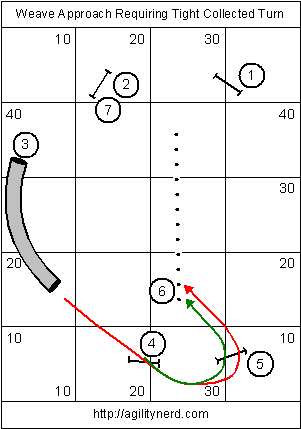Top Spin
05 Apr 2013
This is a handling move I found myself doing as part of a Dana Pike course and didn’t know it had a name until she told me it was called a “Top Spin”. In 15+ years of dog agility I’d never heard of it before… It was very useful in this case.
Here’s an excerpt from an agilitynet article Bud Houston’s Basic Handler Moves in which Bud Houston describes top spin:
I think Bud’s definition is entirely accurate. The only thing I’d add that detracts from the RFP is when you rotate back (to move forward again) that shoulder rotation is like a Shoulder Pull Learning the Post TurnPost Turn/Shoulder Pull/Pivot Turn which tends to push on the dog’s path; thereby moving the dog slightly away from the handler. In some scenarios that rotation back could be enough to push the dog off the desired path (or weave entry in my case below).
The problem with giving an example of using any handling maneuver is whatever sequence I choose ends up causing a big handling discussion about why some other way of handling would have been better. Oh well, let’s see if anyone can resist leaving that kind of comment…
Here is a simple sequence loosely based on Dana’s larger course:

As above, in Dana’s course the dog was going through a 180 to 270 Mr Peabody in UKC Bloodlines MagazineHandling 270 Degree Jump SequencesBack Side Entry to 270/Training Opportunity - Video270 Degree Jump Sequence of jumps where the second jump was very close to and offset from the weaves for a tough On Side weave entrance. The dogs really needed to turn tightly with collection over the second jump to hit the weave entrance. Unfortunately the layout of the course, specifically the dog’s approach to the 270, meant it was hard to give them enough turning cues on the approach to the jump. Front crossing over the last jump (to “enforce” the dog’s line to the weaves) also put you on the wrong side of the weaves for the rest of the sequence. Yes you could have front crossed and immediately rear crossed the entrance to the weaves (but I don’t like to Cross In/Cross Out or you could have crossed the exit of the weaves. But my goal was to could give enough turning cues to get the weave entrance without the front cross.
In this case the dog comes over jump 4 on the handler’s right. If you use an RFP you shoulder pull over 5, hold your ground (no forward motion), rotate in to the dog (rotate to the right) to bring the dog in to the handler and, once the dog comes in, rotate back to the left and direct the dog to the weaves. That is a lot of handling and timing in the short space before the weaves.
So what is the Top Spin maneuver already?!! Just like the RFP, dog on right over 4. In this case rotate in toward the dog (rotate to right) as dog approaches jump 5 (giving collection cues on approach to jump) as dog commits to jump the handler continues rotating right until they’ve turned completely around and are facing the weaves with the dog on their right. It turns out the “counter rotation” (a 360 degree rotation); really causes the dog to turn in to the handler. As you’ll see in the video, I found the rotation could easily pull Flyer off the jump if I didn’t give a verbal “jump” cue to support the jump.
Just to be clear, this is not a Ketschker (aka a (Mitchell) Flip). The initial cues (facing the dog as it approaches the jump and arm cue) look similar but the handler’s motion is what makes this a Top Spin. In the Ketschker the handler’s motion is primarily backward toward the jump and, when the dog is committed, forward away from the jump (completing the Blind Cross). In the Top Spin the handler rotates 360 degrees and continues in the direction of the dog - dog continues in a mostly forward direction - the dog does not Wrap Jump Wrap Handling TipsJump Wrap Handling - With VideoJump Wrap/Wrap the jump.
There is no point in drawing a diagram for the motion, it would be just as complicated as the description I just gave! Let’s see some handling attempts for the two jumps & weaves, and finally the Top Spin in action and hopefully it will make more sense:
I think Flyer did a really nice job understanding the cues for my different handling methods. We haven’t worked much on such tight weave entries so I couldn’t be happier. Watching the video, my handling was a little late in spots and he still did his best.
I haven’t seen that many places where a Top Spin would be helpful, but I’ll keep my eyes open. It is nice to know how it works and see first hand just how well it can work!
Update 2020-06-29
Seven years later, this “move” is mostly just called a “Spin” here in the US. Its use seems to be dying down a little, but handlers executing “random acts of spinning” was kind of a thing a couple years ago.
When people first see the effect of the added collection cues the spin provides, especially for fast dogs who prefer extension, they tend to use it frequently. Adding/reinforcing other collection cues can be a simpler and better solution that doesn’t require as much counter motion from the handler and lets the handler move on to the next obstacle.
If you enjoyed this article won't you please:  Thanks!
Thanks!
